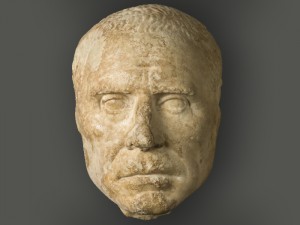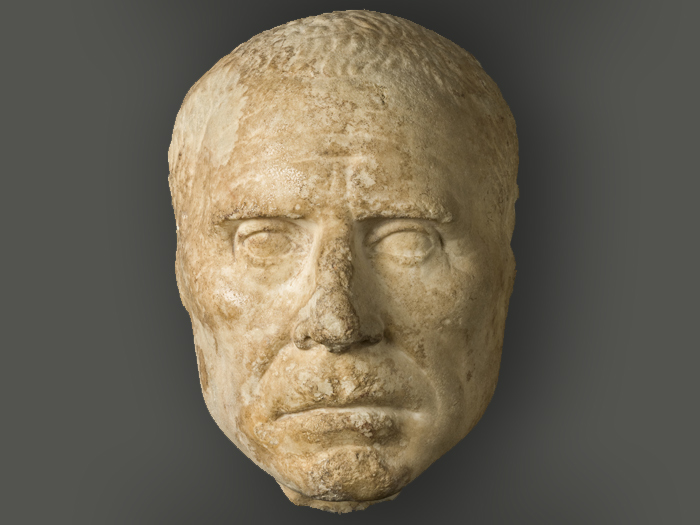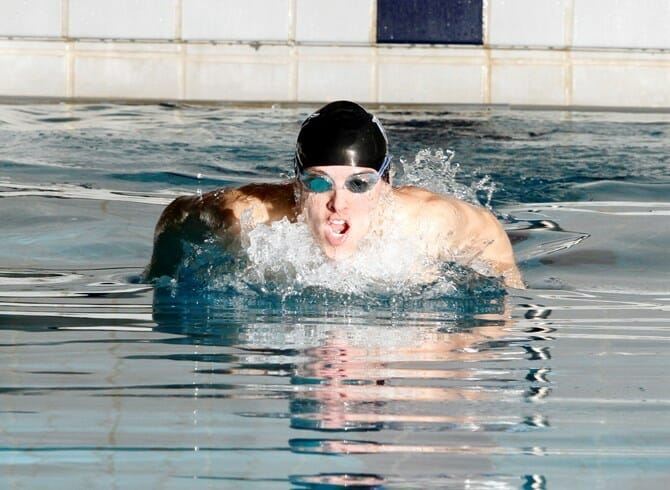
Head of a Man Italy, Rome, found at Baia, near Naples 1st Century B.C. – 1st century A.D. Marble, H. 9 ¼ in. Gift of the Ingram Merrill Foundation and the Piero Tozzi Gallery, 1963. A1963.83. Collection of the Staten Island Museum
A new exhibition of antiquities from ancient Egypt, Greece, Italy, and the ancient Americas will open in 2014, thanks to an innovative collaboration between curatorial staff at the Staten Island Museum (SIM) and History Department faculty and students at the College of Staten Island of the City University of New York (CSI-CUNY).
Sheltered for more than a century at the Staten Island Museum’s headquarters in St. George, Staten Island NY, the ancient artifacts have been reviewed in preparation for the exhibit by SIM Curator of Art, Robert Bunkin, Nancy Rosoff, Andrew W. Mellon Curator of Arts of the Americas at the Brooklyn Museum of Art and CSI-CUNY History Department Chairperson Professor Eric A. Ivison, with the participation of graduate student-interns in the CSI History Master of Arts Program.
 A SIM-CSI initiative focusing on Egyptian, Greek and Italic antiquities was developed by CSI Professors Ivison and Linda Roccos, with the enthusiastic support of former SIM Art Curator Bart Bland and SIM Director and CEO Elizabeth Egbert. The goal of the project was to create a “museum without walls” that could foster discovery learning in CSI students by using the artifacts for teaching and study.
A SIM-CSI initiative focusing on Egyptian, Greek and Italic antiquities was developed by CSI Professors Ivison and Linda Roccos, with the enthusiastic support of former SIM Art Curator Bart Bland and SIM Director and CEO Elizabeth Egbert. The goal of the project was to create a “museum without walls” that could foster discovery learning in CSI students by using the artifacts for teaching and study.
“The collaboration between CSI and the Museum began in 1999 with a co-initiative launched by CSI faculty and the organization then known as the Staten Island Institute of Arts & Sciences,” said Professor Ivison. “Since then, the teamwork between us has forged a successful, ongoing student-internship program, as well as the Staten Island Museum’s Archaeology Study Collection project at the College, which cataloged the details of several hundred artifacts formerly on loan to the CSI Library from the Museum.”
During the past 13 years, the SIM@CSI Archaeology Study Collection of ancient antiquities has been used by CSI faculty for innovative, “hands-on” instruction and as research projects for hundreds of students. The project is also supported by a Website developed by CSI professors Ivison and Roccos entitled, Staten Island Museum at CSI: Archaeology Study Collection for Ancient and Medieval Civilizations (accessed 10.08.13).
The collaboration has also grown over the years: in 2002 a major art work in the SIM collections, a large cartoon for a mural entitled Angel of the Sun, by noted American artist John LaFarge (1835-1910), was placed on long-term loan in the Rotunda of the CSI Library. In 2010 the Archaeology Study Collection returned to the SIM in preparation their display in the new “Treasure Box” galleries, which will open in 2014 in a newly restored Landmark Greek-Revival building at the Snug Harbor Cultural Center, located on the north shore of Staten Island.
The bulk of SIM’s Mediterranean antiquities that will form part of the new exhibit, once were in the private collection of some 2,000 items formed by Scottish natives Francis MacDonald (1825-1878) and his wife, Elizabeth (Eliza) Wallace MacDonald (1825-1911), Professor Ivison said. Francis MacDonald, a founding member of the New York Produce Exchange and New York agent for the Anchor Shipping Line, enjoyed great financial success, permitting his family to move to the suburb of Clifton on the northeastern shore of rural Staten Island, an area then much favored by the wealthy middle class. Francis and Eliza’s son, David Wallace MacDonald, gave the collection to the Staten Island Museum in memory of his mother, following her death on Aug. 21, 1911.
In terms of size and importance, the former MacDonald Collection constitutes one of the most significant bequests to what was later to become the Staten Island Museum.
TREASURE BOX
Within the MacDonald Collection, Professor Ivison added, “The most significant group of objects were the over 400 ancient antiquities from Egypt, the Levant, Greece, and Italy.” A selection of these antiquities will be displayed in the new “Treasure Box” galleries, along with other highlights from the Staten Island Museum’s permanent collections of world art. The new antiquities exhibit, developed by Professor Ivison and SIM Art Curator Robert Bunkin, will explore the personal histories of collectors and donors like the MacDonald family, and will focus in particular upon the subject of “Ancient Italy” – a topic of interest to many Staten Islanders.
“Until recently, the Museum didn’t have the means or staff to properly record the details of the artifacts in a timely fashion with 21st-century precision,” said Robert Bunkin. “In addition, we wanted to display these treasures within an optimum climate-controlled and viewer-friendly environment. Our goals are seeing fruition due to the Museum’s collaborative educational efforts with CSI, and the anticipated opening of the Museum’s new home at Snug Harbor.”
The Museum’s current expansion project at Snug Harbor, in the Staten Island community of Livingston, follows the 2009 renovation of the adjacent Building H into a new home for its History Archives, and the 2008 launch of both the Staten Island History Center and Art Conservation Studio.
The new building, said Museum Exhibitions and Program Director Diane Matyas, “will embrace more than 10,000 square feet of public space. This will provide us with the opportunity to showcase a greater number of natural science objects, and fabulous artworks that – like the ones highlighted by our most recent inventory initiative – have been out of the public eye for many decades.”
COLLEGE INTERNS BENEFIT
One of the artworks to be featured in the new “Treasure Box” galleries will be the Roman marble portrait “Head of Man.” This artwork, said to be from Baiae near Naples, Italy, and dated to between the First Century BCE and the First Century CE, was presented to the Museum in 1963 by the Ingram Merrill Foundation and the Piero Tozzi Gallery.
Frank Cretella, who earned a BA in History at CSI and who has worked as an intern at the Museum, researched the portrait in Professor Ivison’s graduate class in the CSI History Master’s Program. “It was a remarkable experience,” said Mr. Cretella. “It’s one thing to look at objects on the page of a book; it’s totally different to hold the actual artifact in your hands, examine it, measure it, and study it.” Mr. Cretella is currently studying for an MA in Classics at the CUNY Graduate Center.
Jennifer Williams, another graduate student of Professor Ivison at CSI and an intern at the Museum, is preparing a History Master’s thesis on the collection of Pre-Columbian antiquities, some of which will also be featured in the “Treasure Box” galleries. Among the many important pre-Columbian artifacts rediscovered by Williams during her research at the museum is a spondylus pendant with a shell-bead necklace. “This was a particularly exciting find for me because spondylus (a spiny, brightly colored shell) was a sacred material to many Andean cultures including the Inca,” she said.
For additional information visit www.statenislandmuseum.org




![[video] The Teacher Wars: A History of America’s Most Embattled Profession](https://csitoday.com/wp-content/uploads/2015/02/SoE-Teacher-Wars.jpg)












